In short, stitch families are the groups to which the different stitches belong. Wondering why it even matters to know this kind of stuff when it comes to your needlepoint hobby? Well, my friend, let me shed some light on it for you… 😉
See, when you understand how stitches fit into families, it helps make choosing the best ones for your projects much easier.
A while back, I adjusted the way I categorize decorative stitches into families.
Instead of the original five families (straight, slanted, cross, looped, and knotted) that I used for a reeeaaaallllly long time, I now have a new way to categorize canvas embroidery stitches. Here’s how it goes…
- Straight stitches are those that lay in a horizontal or vertical direction on your canvas. They can also be slanted. (Diagonal and oblique stitches are straight stitches.)
- Cross stitches are exactly what they sound like – stitches (either straight or slanted) that cross each other.
- Tied stitches, like cross stitches, have one or more stitches that lay on top of another stitch, but there’s a catch – literally (teehee!). The top stitch(es) manipulate(s) the bottom stitch(es) to create angles or curves that are then secured to the surface of the canvas with a tie-down stitch.
- Woven stitches are those in which one or more of the stitches in the pattern weave over and under (at least) one other stitch in the pattern.
- Knotted stitches are those in which the thread is knotted around itself or through the canvas.
What about all the other stitches that don’t fit into one of these families?
Well, they’re likely composite stitches or surface embroidery stitches.
You may also see these groupings for stitches that have a similar composition or method of execution
- box
- diagonal
- eyelet
- leaf
- line
- decorative
- ribbon
- open.
I have to say, though, that I don’t find the above groupings as helpful as the ones I use.
Need some examples to help you make sense of all this talk about stitch families?
Let’s start with the Straight Stitch Family.
This is, by far, the largest stitch family. Remember, straight stitches can be vertical, horizontal, diagonal, or oblique as long as they do NOT bend or twist around another stitch to form a knot, aren’t woven over or under another stitch, or do not lie across another stitch.
An example of a vertical straight stitch is the Parisian stitch. The stitches that make up the pattern have a vertical – or upright – orientation.
The medieval mosaic stitch is a horizontal straight stitch. That means the stitches in the pattern lie on the canvas in a horizontal direction – from east to west. Here’s a diagram for the medieval mosaic stitch, so you can see what I’m talking about. 🙂
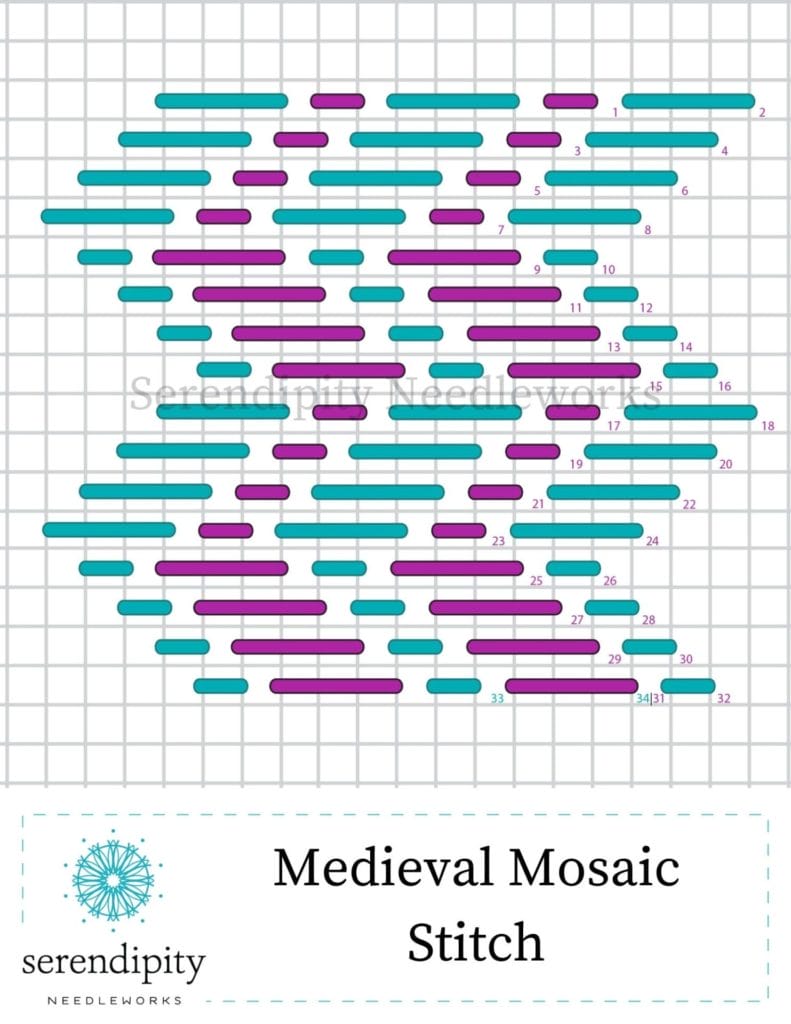
The other two kinds of straight stitches have a lean – or slant – to their orientation.
I’ll bet that sounds “wrong” to you because, intuitively, if the stitches are supposed to be considered straight, they wouldn’t have a slant. But let’s take a peek at that definition of what constitutes a straight stitch again…
Straight stitches can be vertical, horizontal, diagonal, or oblique as long as they do NOT
- bend
- twist around another stitch to form a knot
- aren’t woven over or under another stitch
- or lie across another stitch
Now, back to our slanted straight stitches…
A diagonal stitch is one that covers the same number of vertical AND horizontal canvas threads. The tent stitch is a true diagonal straight stitch. (It covers one vertical and one horizontal canvas thread.)
And the encroached slanted Gobelin stitch is an example of an oblique straight stitch. An oblique stitch is any slanted stitch that is not a true diagonal stitch. In other words, it’s worked over a differing number of vertical and horizontal canvas threads.
Here’s the stitch diagram for the encroached slanted Gobelin stitch for you. Notice how this stitch covers one vertical and two horizontal canvas threads?
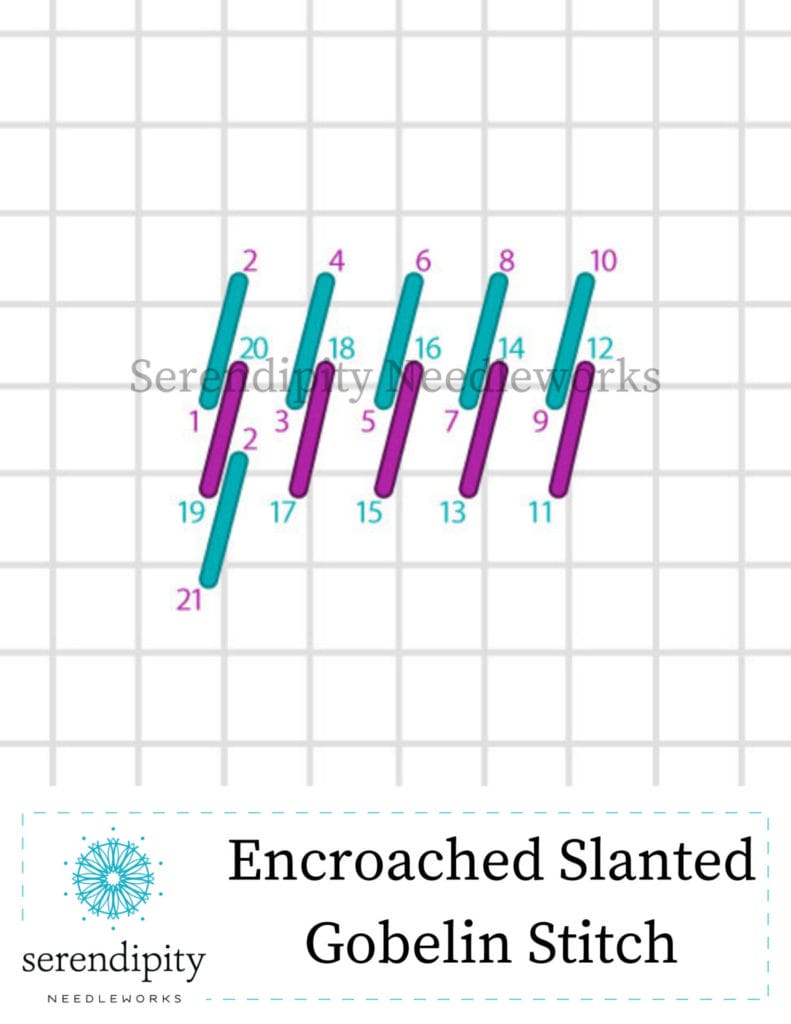
Okey dokey – next up is the Cross Stitch Family.
There are A LOT of cross stitches that y0u can use to create texture on your canvases. In fact, cross stitches, because they have multiple layers, are perfect for adding dimension and visual interest to your canvases. Some examples of cross stitches are the upright cross stitch, the Smyrna cross stitch, the Dutch stitch, the herringbone stitch, and the Rhodes stitch.
Here’s the stitch diagram for the Smyrna cross stitch, so you can see how the stitches lay on top of each other in a cross stitch…

Our third stitch family is the Tied Stitch Family.
Tied stitches are those in which the bottom stitch (or stitches) are manipulated into a particular configuration (think angles and curves), and then secured in place by a tacking stitch/top stitch. If you’re newer to using fancy stitches to embellish your canvases, you’re probably thinking “what the heck is she talking about”?!
I’m sure an example or two will help make it more clear…
The lazy daisy stitch is a very common tied stitch. When making a lazy daisy stitch, you manipulate the thread into a loop, then you tie/secure it to the canvas with a tacking stitch. Here’s the stitch diagram for a lazy daisy stitch…

Other examples of tied stitches are the fly stitch and the buttonhole stitch. 🙂
Moving right along, we have the Woven Stitch Family.
Woven stitches are exactly what they sound like: at least one stitch is woven over/under at least one other stitch in the unit or pattern. Waffle stitches are woven stitches, as are Jessica stitches and woven wheel (aka spider web rose) stitches.
Here’s the stitch diagram for making a spider web rose…
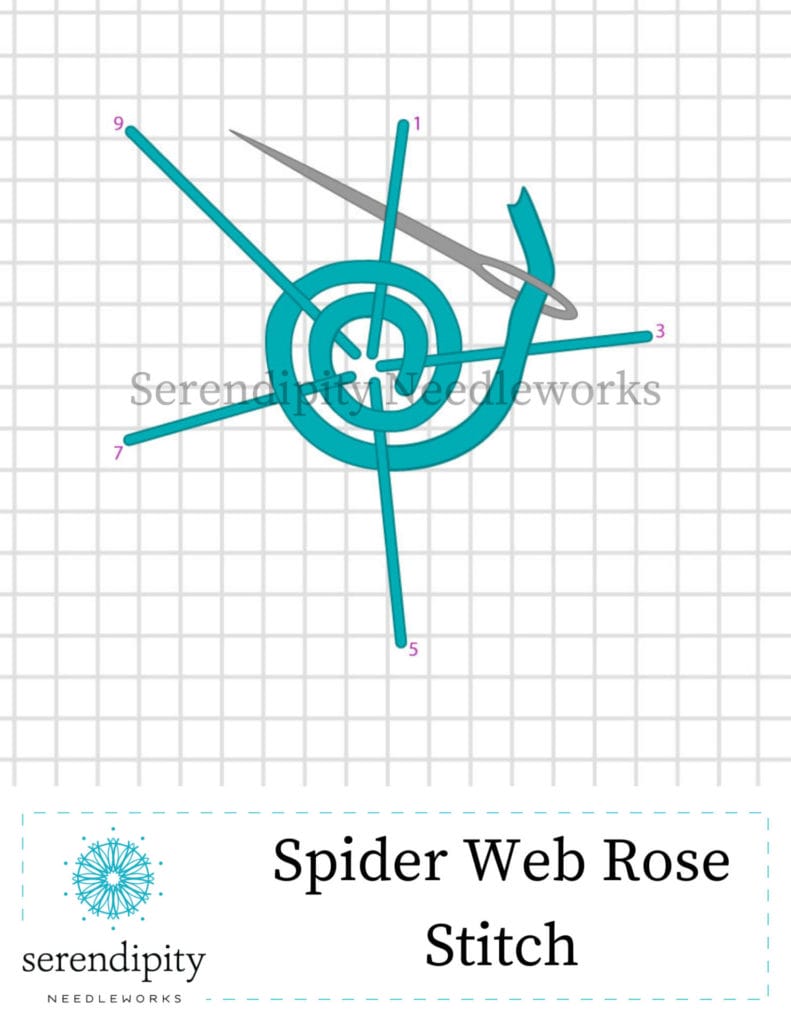
And finally, we have the Knotted Stitch Family.
Some of my favorite stitches are knotted stitches – and these cutie-pie stitches are perfect for adding texture to your canvases. French knots and bullion knots are just a couple of examples of knotted stitches. They’re amongst my all-time faves, too! 🙂
I especially love to make French knots. Here’s my stitch diagram, in case you want to give it a try yourself…
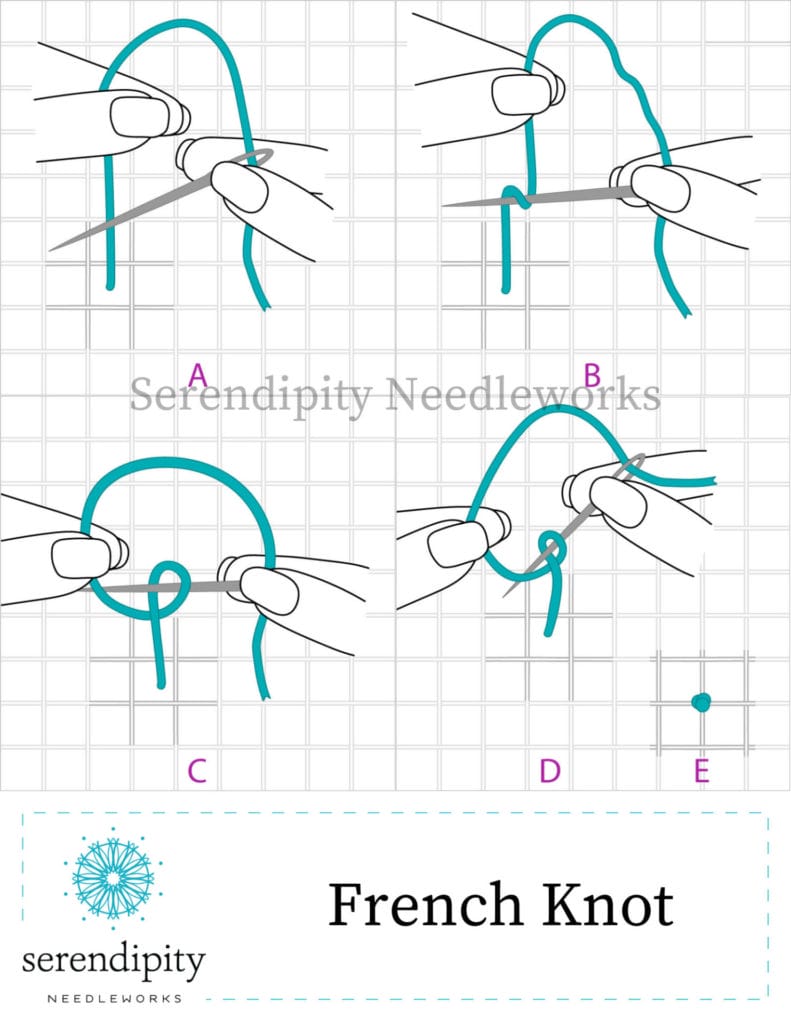
And don’t fret – if French knots make you antsy, just try practicing on a doodle canvas with a single strand of silk (e.g., Vineyard Classic or Pepper Pot silk) or DMC Pearl Cotton 5. Smooth threads are much easier to manage when executing any kind of knotted stitch. (Wool tends to stick to itself.)
Be sure to check out my video for how to make French knots over on our YouTube channel, too. 😉
Alrighty – that brings us to the end of our chat about stitch families.
Next time, we’ll explore how stitch families relate to each other – and how you can use that knowledge to choose stitches that work well together on your needlepoint projects.
Thank you ever so much for joining me here today and, until next time…
Happy Stitching!!
XOXO!



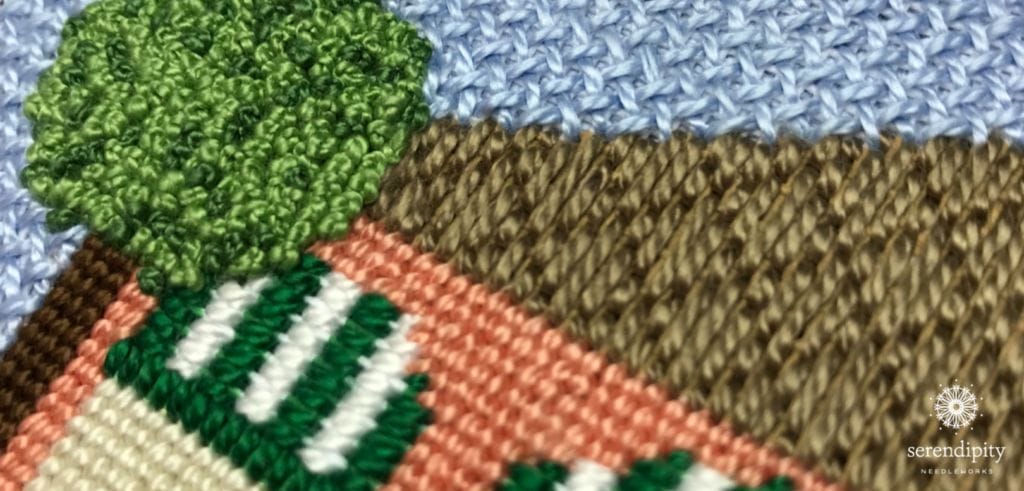


Ellen, I love your short tutorials and can’t wait until I have time to take one of your courses. Right now I am working on a knit afghan and a crochet afghan bbut unfortunately in Feb. I had to have triple coronary bypass surgery. Now I am recovering from a femoral-tibial bypass and a carotid bypass procedure. Until Feb. I thought I was just fine and then the bottom fell out. Your email letters were eagerly awaited. Congratulations on your new grand baby. I know she will be a great joy to you. Keep teaching us old dogs new tricks.
Hi Jane!
Thank you for your sweet note. I’m so sorry you’ve been under the weather. My mother had 5 bypasses back in 2018, so I know how difficult these past few months have been. Mama was the same way – we had no idea she had any issues at all.
I’m glad you have your needlework to keep your hands busy. 🙂
And we’re overjoyed with our new granddaughter – it just keeps getting more and more fun!
I hope you have a restful weekend. Until next time, happy stitching!!
XOXO!
Ellen
This is SO helpful! Thanks.
Hi Jayne
Thank you for your note. I’m so glad you found the info helpful.
Happy Stitching!!
XOXO…
Ellen
I am currently “designing” my stitch choices for a Scott Church Canvas : penguins with the tree. Am interested in how to balance my stitch families for sky, snow/water, etc.
Hi Shirley
Great question! I’ll be chatting more about this in next week’s blog post, so be sure to check it out. 😉
But to help you get started now, here are a couple of ideas…
I tend to use stitches with a horizontal orientation for the sky. If the water is not frozen, as it is on your canvas, I usually choose something that implies a wee bit of movement. It can still have a horizontal orientation, but I prefer to use something different enough to create some contrast. With snow covered ground – like you have on your project – you can use a stitch with a neutral read… something like the Nobuko stitch or the balloon stitch. (Both of those are in your Stitcher’s Club How-To Stitch Library. 🙂 )
Can’t wait to see what you come up with – and remember, you can always ask questions over in our Community, too.
Have a terrific weekend…
XOXO!
Ellen
This was so, so helpful! Can’t wait to see how to use info in my projects. Real down to earth help! Thanks
Hi Eleanor
Thank you for taking the time to let me know that you found the info this blog post helpful. 🙂
Be sure to tune in next week when I’ll share some tips for how to identify stitches that work well together on your projects.
Have a terrific weekend and happy stitching!!
XOXO!
Ellen
You explained the different stitch families; however, I am not sure how this helps to know how pick stitches that work together on the canvas. Is there a set of rules to follow here?
Hi Marcia
Thank you for taking the time to read my blog post – and for your comments. 🙂
There are definitely some guidelines that you can follow – and I’ll dive deeper into the topic of how to pick stitches that work well together next week.
Have a restful weekend.
XOXO!
Ellen
Do you have a printed book with all the needlepoint stitches , how to stitch, when to use etc?
Hi Leonie
Thank you for your note. I don’t currently have a printed book, but I do have a membership program called The Stitcher’s Club that includes a how-to stitch library, complete with video tutorials and downloadable stitch diagrams. If you’d like more info, please send an email to [email protected]
XOXO!
Ellen